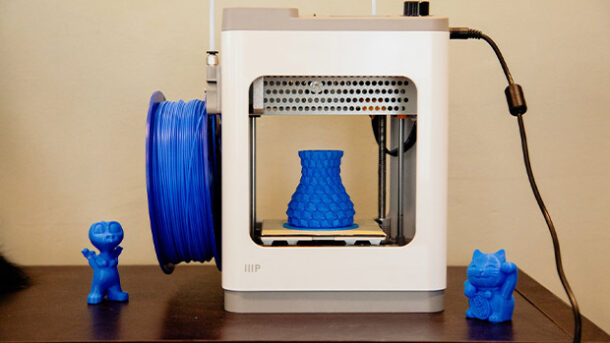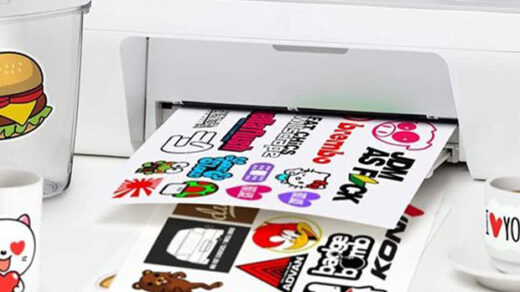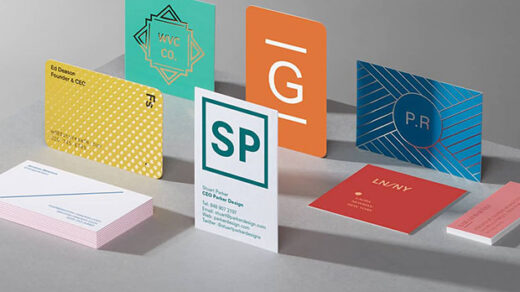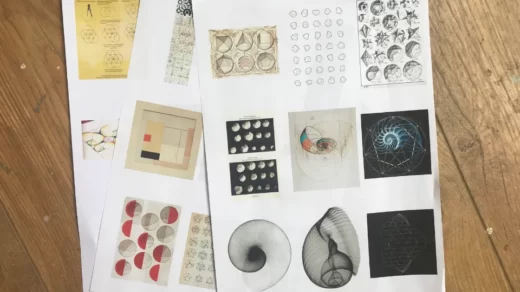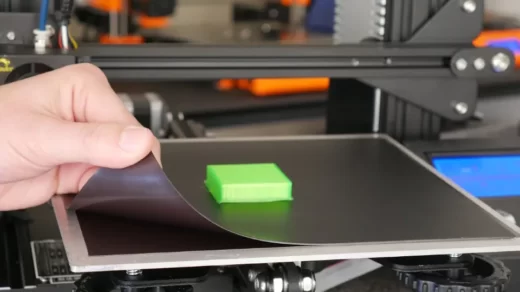With best 3D printer under $500, you can open up the possibility of making custom physical objects to meet my own specific needs.
It can be intimidating to begin though. What kind of printer should you buy? Not all inexpensive 3D printers come with the same features. They create models in various sizes and levels of detail. Below are some best choices we pick up from market:
- Best overall: Creality Ender 3 S1
- Best budget: Creality Ender-3
- Best for beginners: Voxelab Aries
- Best for home: ELEGOO Mars 3 Pro
- Best resin: ANYCUBIC Photon M3
- Best large volume: Artillery Sidewinder SW-X2 3D Printer
Here is our buyer’s guide to the top 3D printers priced under $500, keep reading!
Table of Contents
Best 3D Printers under $500: Reviews & Recommendations
1. Best Overall: Creality Ender 3 S1
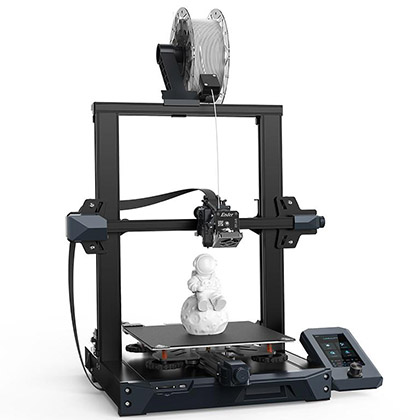
Why It Made The Cut: This incredibly precise FDM is adaptable, simple to set up, upgradeable, capable of printing with a respectable amount of materials, and provides an all-around reliable print cycle.
Specs:
- Print technology: FDM
- Size: 19.2 x 17.8 x 24.5
- Build size: 8.6 x 8.6 x 10.2 inches
- Supported materials: PLA, TPU, PETG, ABS
Pros
- Solid precision
- 16 point automatic leveling
- Supports multiple slicing softwares including Cura
- Easy assembly
- Easily modded for laser engraving with presets
Cons
- Loud prints
- Some of the instructions are confusing
Where FDM printers are concerned, the Creality Ender 3 series has to have some of the best name recognition around, and the Creality Ender 3 S1 exemplifies the qualities that made the brand so famous. There aren’t many better options available for under $500.
The S1 combines a few exquisitely crafted features into one incredibly precise unit. The robust extruder generates temperatures of up to 500 degrees Fahrenheit and exerts substantial pressure while only making slight axe movements. It makes use of two motorized geared Z-axis lifts. A bed with automatic leveling is also provided by the system. This all adds up to the system being precise and adaptable. PLA, TPU, PETG, and ABS are all supported.
The Ender 3 S1 is among the best printers available for under $500 because it has a sizable build area, a broad range of materials it can work with, good precision, and an auto-leveling bed. Anyone looking for a high-quality fused deposition should give it serious consideration.
2. Best Budget: Creality Ender-3
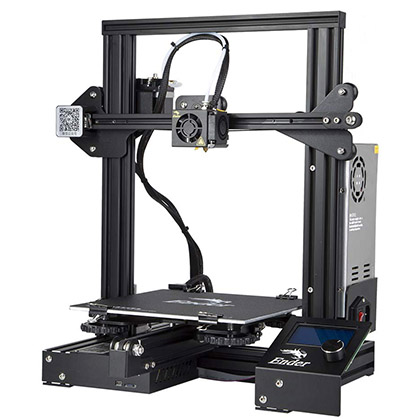
Why It Made The Cut: This open sourced classic, which is arguably the most well-known entry-level 3D printer available, offers a wealth of great fundamentals and features a practical design that’s simple to modify and improve.
Specs:
- Print technology: FDM
- Size: 17.3 x 16.1 x 18.3 inches
- Build size: 8.7 x 8.7 x 9.8 inches
- Supported materials: PLA, TPU, ABS
Pros
- Easy to use
- Moddable
- Great community support
- Very affordable
Cons
- Requires manual leveling
- Noisy
- Assembly is involved and best use will require extra work
Released back in 2018, the Creality Ender-3 is to 3d printing what the The ubiquitous, affordable, and reliable Squier is to electric guitarists. The Ender-3, the younger sibling of our top pick overall, is a straightforward 3D printer that comes with everything the majority of users require to get going, despite the fact that it lacks some high-end features and perfectly leveled components.
The Ender-3 can handle the traditional thermoplastics like PLA, TPU, and ABS and even exceeds temperatures offered by some more expensive printers. It may not be able to handle the most sophisticated thermoplastics, but it can handle the classics thanks to a manual leveling tray that heats to 230°F and a basic extruder that heats to 491°F. Additionally, it features a resume print feature that will bring it back online in the event of interruptions, power outages, or filament shortages.
This printer’s complex assembly is its main drawback. Although it can be put together in about two hours, the process is difficult, and print quality will be improved when extra time and care are taken to correct for errors. That being said, the printer’s strong suit is its open-sourced DIY ethos, which is also one of its selling points. Another is the printer’s extensive community support in online forums and potential for moddability. In the end, if you use your Ender-3 as a 3D printer building kit rather than just a 3D printer, it can provide you with everything you need, including some of the comfort and quiet found in high-end contemporary machines that cost much more.
3. Best for Beginners: Voxelab Aries
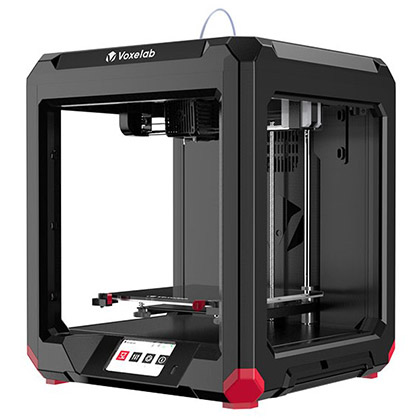
Why It Made The Cut: The Voxelab, which is designed for beginners, is a great place to start (and advance), thanks to its extremely simple setup, comparatively simple manual leveling, wifi, and straightforward controls.
Specs:
- Print technology: FDM
- Size: 16.69 x 15.98 x 18.46 inches
- Build size: 7.9 x 7.9 x 7.9 inches
- Supported materials: PLA, ABS, PETG
Pros
- Easy auto-leveling
- Simple to control with Wifi
- Voxelmaker software allows control of multiple printers simultaneously
- Arrives assembled
Cons
- Leveling requires manual inputs
- Loud and annoying sounds
For those who might be experiencing a little trepidation about getting into the 3d printing game, the Voxelab Aries is an easy front runner to help you get settled and explore. The Voxelab makes use of straightforward harmony, despite the fact that the printer’s namesake Aries is the Greek god of war. This printer comes pre-assembled and loaded with PLA filament in an open box and performs almost plug-and-play.
While the Aries doesn’t feature true auto-leveling, it does make it easy on you, with simple knob adjustment and a 3 point leveling system — this is why the company advertises the device as “semi-auto leveling.” The printer can print PLA, ABS, and PETG with a maximum extruder temperature of 482 degrees Fahrenheit. Its heated textured glass bed reaches 212 degrees Fahrenheit for adequate adhesion.
This device’s connectivity and ease of use are what make it so enjoyable. The Aries uses the Voxelmaker software, which can slice and command multiple Voxelab printers. Using your computer, setting modifications are also simple to configure. The Voxelab Aries is a fantastic learning rig thanks to its pre-assembled design, WiFi connectivity, and even 8 GB of internal memory.
4. Best for Home: ELEGOO Mars 3 Pro
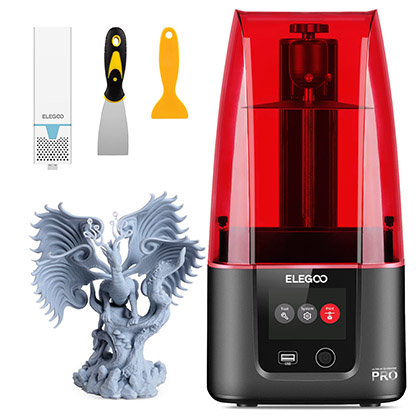
Why It Made The Cut: This SLA printer excels at producing fine art prints with outstanding resolution and detail.
Specs:
- Print technology: SLA
- Size: 8.93 x 8.93 x 17.28 inches
- Build size: 3.5 x 5.6 x 6.9 inches
- Supported materials: Resin
Pros
- High detail prints
- Consistent print quality
- 4k monochrome light
- Free Chitubox sample subscription
Cons
- Setup instructions aren’t the clearest
If it’s your Instagram followers applauding your custom Warhammer figurines or your mother when you print her that intricate new set of corn-cob skewers for the potluck, resin prints offer resolution and detail that’s sure to impress anyone. Whatever you’re printing, if it’s details that count, then you can’t do much better than the ELEGOO Mars 3 Pro.
The ultra-high resolution of this 4k monochrome printer, which makes use of extremely dense chip-on-board integrated LCDs, translates to more detail and fewer errors. It has heat dissipation technology, which will increase its longevity, and it also boasts an improved release film, both of which set it apart from earlier models. A one-year subscription to Chitubox is included with the device, giving you access to robust SLA print software that offers all the essentials as well as advanced features that will challenge even seasoned 3D printers. The Mars 3 Pro also functions with Lychee Slicer if Chitubox isn’t your thing.
5. Best Resin: ANYCUBIC Photon M3
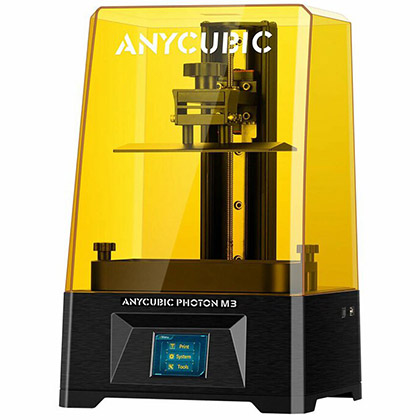
Why It Made The Cut: Because of its broad community support and ease of use, this plug-in SLA printer consistently produces detailed prints with no system print errors.
Specs:
- Print technology: SLA
- Size: 16.7 x 10.6 x 10.1 inches
- Build size: 7.1 x 6.4 x 4.0 inches
- Supported materials: Resin
Pros
- Extremely precise 4k LCD print
- LCD control screen
- Wide user base for support
- Decent build size for price
Cons
- Requires manual leveling
4k prints — they offer better resolution, smoother texture, and greater detail, and if you’re after a 4k 3d LCD printer for your home or workshop, you can’t do much better than the ANYCUBIC Photon M3. In comparison to the ELEGOO Mars 3 Pro, the Photon offers slightly larger print sizes. It is a cheap printer in a line of 3D printers that also features some genuine high-end technology.
A checkerboard-textured build plate and a high contrast 4k screen are both features of the Photon M3 that improve adhesion. A front LCD control screen that enables better device control is one of its distinguishing features. Speaking of control, the printer allows for adjustable UV power, which makes it compatible with a (slightly) wider range of resins. Check the UV rating on your resin of choice before you buy, though, to ensure that it is supported. Additionally, it has a UV-blocking cover that blocks harmful light from the LCD exposure process.
The Phonton M3 is a fantastic option due to its extensive user support network, superb clarity, UV-blocking shield, and controls with LCD panel. Whether it defeats the ELEGOO is up to you, but there is no denying that its print quality is exceptional considering its affordable price.
6. Best Large Volume: Artillery Sidewinder SW-X2 3D Printer
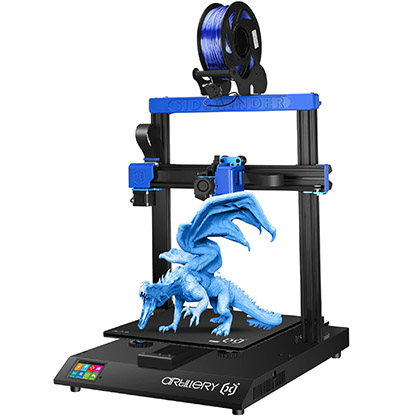
Why It Made The Cut: For a printer at this price, the Artillery Sidewinder provides an impressive build volume without sacrificing quality or user-friendly features.
Specs:
- Type: Filament
- Built Volume: 11.8 inches L x 11.8 inches W x 15.75 inches H
- Speed: 5.9 inches per second
Pros
- Large build volume
- Arrives 95 percent assembled
- Auto bed-leveling
Cons
- Filament holder could be improved
- Poor customer support
With its impressive print volume, the Artillery Sidewinder is definitely the best affordable 3D printer for creating large models. To provide a machine of this capability for the price would not be surprising if the company had made other cuts, but that doesn’t appear to be the case. A few things could be done better, but overall there aren’t many problems.
While not particularly quick, the Artillery Sidewinder can produce layers with a thickness of 100 microns (0.0038 inches), so its quality is on par with that of many smaller devices. Only the ribbon cable and spool holder need to be put together when it is almost ready. The latter’s quality isn’t the best, so there are occasionally feed errors, but if there are any interruptions, the printer will continue from where it left off. The controls on the touch screen are also very simple to use.
The Artillery Sidewinder’s auto-leveling is unusual for a low-cost 3D printer, which saves time and aggravation. The glass bed warms up in about two minutes, so printing can begin quickly and quietly. The Artillery Sidewinder can be difficult to get to its optimal performance, but that is typical of low-cost 3D printers. Despite some owners’ criticism of customer service when issues arose, the machine is generally very dependable.
Read More: How To Clean A 3D Printing Bed?
Things to Consider before Buying a 3D Printer under $500
Choosing a 3D printer under $500 presents few restrictions because there are so many high-quality machines available today. But there are a few crucial issues that demand some consideration.
Build Volume
Most people’s decisions will be heavily influenced by the size of the projects that a 3D printer can produce, but this is only one factor. It’s a good idea to not only concentrate on size because this can lead to weaknesses in other areas.
Also Read: How Much Electricity Does a 3D Printer Use?
Resin Or Filament
Although resin 3D printers are typically more expensive than their filament counterparts, they frequently produce more intricate models. Alternatively, filament usually results in a model that is more robust. If you are unsure of how each performs, the type of filament can make a significant difference and is worth investigating further. Bear in mind while the best 3D printers can use a wide variety of materials, sub-$500 models may have more limited choices.
Speed
Because print times can vary greatly, most people are understandably impatient to see their finished 3D object. Typically, filament printers are a lot quicker than resin printers. The fact that resin 3D printer speeds are expressed as the height of models produced per hour and filament 3D printer speeds as the speed of the nozzle can make the numbers confusing. Both can be used for comparisons, but neither provides a very precise estimate of how long a specific model will take.
Also keep in mind that with filament printers, the maximum speed may not be used frequently. The optimal speed for common filaments like PLA is only about 2 inches per second, despite the fact that our best budget 3D printer can print at speeds of up to 7 inches per second.
Related Post: Is 3D Printing An Expensive Hobby?
Final Thoughts on Best 3D Printers under $500
When you invest in a 3D printer under $500, you invest in bringing your vision into physical form. With a few mouse clicks, these amazing machines extrude 3D prints from plastic.
If you’re new to the game, the Voxelab Ariesis the best option for beginners, coming pre-assembled and preloaded with filament, and offering easy Good controls and WiFi connectivity.
If you’re after exceptional detail for prints of figurines, or rigid prototypes, the ELEGOO Mars 3 Pro is an exceptional resin printer with excellent accuracy.
If you want the most bang for your buck under $500, the Creality Ender 3 S1 is an amazing An auto-leveler and other high-end parts are included with this FDM printer, which can be modified and upgraded to become even more effective with a little work. Expect high-quality prints regardless of your decision.
You May Also Like: Best 3D Printer For Miniatures
FAQs
Are 3D Printers Illegal?
3D printers are completely legal. The sale and duplication of items covered by patents or copyrights are prohibited. Making well-known video game figures for personal use, for instance, is acceptable. trying to sell them is not, and may bring a lawsuit from the rights owner.
Do All Cheap 3D Printers Use PLA?
While the vast majority of filament-based 3D printers do use PLA, not all inexpensive 3D printers do. FDM and SLA are the two main categories of inexpensive 3D printers. PLA is a popular type of filament used in FDM printers. FDM printers do not support PLA because they use resin as opposed to filament.
Can 3D Printers under $500 Work With Any Software?
3D printers under $500 work with lots of software, but not all printers work with all software. To determine whether a printer is compatible with your preferred software, look at the spec sheet for the printer you’re considering.

